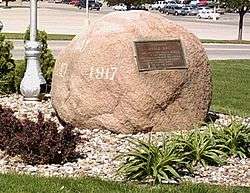Merle Hay
Merle David Hay (July 20, 1896 – November 3, 1917) was the first Iowa serviceman and perhaps the first American serviceman to die in World War I, along with Corporal James Bethel Gresham of Evansville, Indiana and Thomas Enright of Pittsburgh, Pennsylvania.[1]
Merle Hay | |
|---|---|
| Born | July 20, 1896 Carrollton, Iowa], US |
| Died | November 3, 1917 (aged 21) Artois, France |
| Buried | West Lawn Cemetery, Glidden, Iowa |
| Allegiance | |
| Service/ | United States Army |
| Years of service | 1917 |
| Rank | Private |
| Unit | Company F, 16th Infantry Regiment, 1st Infantry Division |

Early life
Merle Hay was born on a Carroll County, Iowa farm to Harvey and Carrie Hay. He was the oldest of 3 children. In 1909, the family moved to another farm near Glidden. Before his service with the United States Army, he was a farm implement mechanic.[2]
World War I service

When the United States entered the First World War, Hay was young enough to avoid being drafted. With his father's blessing, he voluntarily enlisted on May 9, 1917.[3] He was among 8 men from Glidden who enlisted that day. They were first shipped to Fort Logan, Colorado, then to Fort Bliss in El Paso, Texas.[2] He was assigned to the 16th Infantry Regiment. On 26 June 1917, the regiment disembarked the troop ships in St. Nazaire, France, as part of the 1st Infantry Division. By November 1917, he was assigned to Company F along with Corporal James Bethel Gresham and Private Thomas Enright. They were posted in the trenches near the French village of Artois. In the early morning of 3 November 1917, the Imperial German Army attacked. After an hour of fighting, Hay, along with Corporal Gresham, and Private Enright were the first three casualties of the American Expeditionary Force.[4]
Two days later, on 5 Nov 1917, Enright, Gresham, and Hay were buried near the battlefield where they had died. An inscription marked their graves: "Here lie the first soldiers of the illustrious Republic of the United States who fell on French soil for justice and liberty." Their bodies were eventually returned to their families and reburied in the United States. Hay was then re-interred in July 1921 in West Lawn Cemetery in his home town of Glidden, Iowa. The West Lawn Cemetery was later renamed the Merle Hay Memorial Cemetery. An 8-foot monument commissioned by the Iowa Legislature marks his gravesite.
Shortly after Hay's death, the highway running from the west edge of Des Moines to Camp Dodge was renamed Merle Hay Road. A memorial boulder was placed along Merle Hay Road in 1923 and remains up today amidst the commercial development along the road.[5] Merle Hay Mall in Des Moines was also named for Hay; the local Kiwanis club placed a memorial plaque near the entrance to the mall's Sears store in 1979.
The first American military casualty in World War II was also an Iowa native. Andrew, Iowa, native Robert M. Losey, a military attache, was killed on April 21, 1940 during a German bombardment of Dombås, Norway. Captain Losey had been attempting to complete the evacuation of the American diplomatic delegation from Norway to Sweden in the wake of the German invasion.[6]
Family
Hay's mother collapsed upon hearing of his death but in an interview two days after Hay's father, D. Hay, said that "I am proud of my boy if he has given up his life for his country." He was survived by a younger brother Basil, eighteen, and a fourteen-year-old sister Opel.[3]
See also
_(14800169483).jpg)
First killed in WWI
- Albert Mayer (soldier), the first Imperial German Army soldier killed, 1914
- Jules Andre Peugeot, the first French Army soldier killed, 1914
- John Parr, the first British Army soldier killed, 1914
- Thomas Enright, one of the first three American Army soldiers killed, 1917
- James Bethel Gresham, one of the first three American Army soldiers killed, 1917
Last killed in WWI
- George Edwin Ellison, the last British Army soldier killed in World War I, at 9:30 a.m. 11 November
- Augustin Trébuchon, last French soldier killed, at 10:45 a.m. 11 November
- George Lawrence Price, last Commonwealth soldier killed in World War I, 10:58 a.m. 11 November.
- Henry Gunther, last soldier killed in World War I, at 10:59 a.m. 11 November.
Bibliography
Notes
References
- Cleverley, J. Michael (December 2003). "The First American Official Killed In This War" (PDF). Foreign Service Journal. American Foreign Service Association. 2003 (December): 66–68. ISSN 0146-3543. Retrieved January 12, 2018.CS1 maint: ref=harv (link)
- Connors, Michael (November 11, 2007). "The Next Page: Finding Private Enright". Pittsburgh Post-Gazette. Retrieved January 11, 2018.CS1 maint: ref=harv (link)
- Evening Public Ledger pg1 (November 5, 1917). "Casualty List In First Action Thrills Nation". Evening Public Ledger. Philadelphia: Cyrus H. K. Curtis. pp. 1–22. ISSN 2151-3945. LCCN 83045211. OCLC 9355469. Retrieved January 12, 2018.CS1 maint: ref=harv (link)
- Evening Public Ledger pg7 (November 5, 1917). "Proud to have given son to Nation's cause". Evening Public Ledger. Philadelphia: Cyrus H. K. Curtis. pp. 1–22. ISSN 2151-3945. LCCN 83045211. OCLC 9355469. Retrieved January 11, 2018.CS1 maint: ref=harv (link)
- The Glidden Graphic (November 8, 1917). "Glidden Boy First American Killed in France" (PDF). The Glidden Graphic. ISSN 0746-6196. OCLC 10164185. Retrieved January 11, 2018.CS1 maint: ref=harv (link)
- Strong, Jared (2006-03-24). "Veterans cast light on memorial". The Des Moines Register. p. 3B.CS1 maint: ref=harv (link)
External links
- "Merle Hay". Find a Grave. Retrieved 2009-02-23.